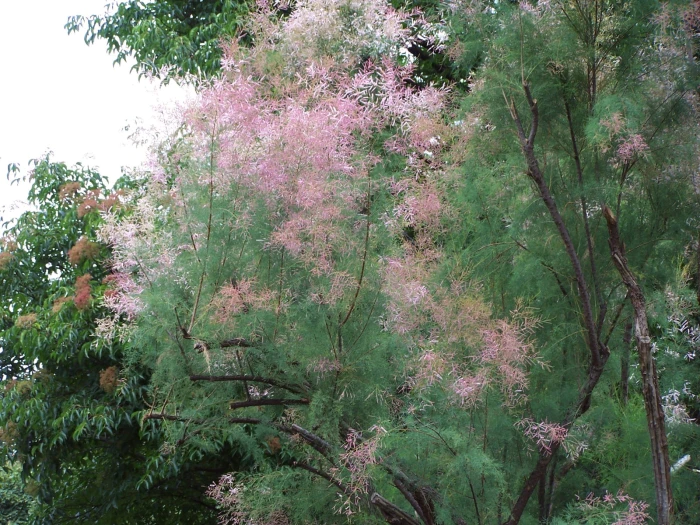Saltcedar
(Tamarix ramosissima)
Saltcedar (Tamarix ramosissima)
/
/

Jerzy Opioła
CC BY-SA 3.0
Image By:
Jerzy Opioła
Recorded By:
Copyright:
CC BY-SA 3.0
Copyright Notice:
Photo by: Jerzy Opioła | License Type: CC BY-SA 3.0 | License URL: http://creativecommons.org/licenses/by-sa/3.0/ | Uploader: Selso | Publisher: Wikimedia Commons | Title: Tamarix_ramosissima_a2.jpg | Notes: '''Pacific Yew''' * '''Description:''' Pacific Yew ([[Taxus brevifolia]] bark * '''Viewpoint location:''' Quarry walking trail near west creek (unnamed) crossing, Oregon State University McDonald-Dunn Research Forest, north of [[Corvallis, Oregon]] * '''G |



















































Estimated Native Range
Climate Requirements for West Palm Beach, Florida
| This Plant | Your Site | Plant Suitability for Your Location | ||
|---|---|---|---|---|
| • Precipitation | 13" - 22" | 59" | Aquatic | Aquatic |
| • High Temp. | 82°F - 106°F | 90°F | Your summer temperatures are normal for this plant. | Excellent |
| • Low Temp. | 12°F - 44°F | 57°F | Your winter temperatures are normal for this plant | Excellent |
This plant may not grow well at your location - your precipitation is too high.
Summary
Tamarix ramosissima, commonly known as Saltcedar, is a deciduous shrub or small tree native to dry areas of Eurasia, often found in riparian zones, where it can form dense thickets. It is known for its vigorous growth, reaching up to 8 meters in height and 5 meters in width, with reddish stems and feathery, almost needle-like leaves that give it a delicate appearance. The foliage is bluish-green and becomes a golden yellow in the fall, adding seasonal interest. Saltcedar’s small, pink, five-petaled flowers bloom from late summer to early autumn, creating showy plumes that cover the new wood of the plant and attract pollinators.
Saltcedar is valued for its hardiness, tolerance for poor soil, and ability to withstand salt spray, making it suitable for coastal plantings. It is often used as a screen, windbreak, informal hedge, or specimen shrub in landscapes. The cultivar ’Pink Cascade’ has dark pink flowers and has earned the Royal Horticultural Society’s Award of Garden Merit. In cultivation, it thrives in full sun and prefers well-drained, light, or sandy soils. It requires low to medium amounts of water and can tolerate slow, medium, or fast drainage. However, Tamarix ramosissima is potentially invasive outside its native range, and its aggressive root system can disrupt local ecosystems. It is considered invasive in parts of Eurasia, Canada, and the United States, so gardeners should check local regulations before planting.CC BY-SA 4.0
Saltcedar is valued for its hardiness, tolerance for poor soil, and ability to withstand salt spray, making it suitable for coastal plantings. It is often used as a screen, windbreak, informal hedge, or specimen shrub in landscapes. The cultivar ’Pink Cascade’ has dark pink flowers and has earned the Royal Horticultural Society’s Award of Garden Merit. In cultivation, it thrives in full sun and prefers well-drained, light, or sandy soils. It requires low to medium amounts of water and can tolerate slow, medium, or fast drainage. However, Tamarix ramosissima is potentially invasive outside its native range, and its aggressive root system can disrupt local ecosystems. It is considered invasive in parts of Eurasia, Canada, and the United States, so gardeners should check local regulations before planting.CC BY-SA 4.0
Plant Description
- Plant Type: Tree, Shrub
- Height: 10-15 feet
- Width: 8-13 feet
- Growth Rate: Moderate
- Flower Color: Pink
- Flowering Season: Summer
- Leaf Retention: Deciduous
Growth Requirements
- Sun: Full Sun
- Water: Low, Medium
- Drainage: Slow, Medium, Fast
Common Uses
Bee Garden, Butterfly Garden, Deer Resistant, Drought Tolerant, Erosion Control, Salt Tolerant, Showy Flowers
Natural Habitat
native to dry areas of Eurasia, often found in riparian zones, where it can form dense thickets
Other Names
Common Names: Odessa Tamarisk, Pink Tamarisk, Salt Cedar, Tamarisk, Tamarix, Salt-Cedar, Perstamarisk, Verzweigte Tamariske, Tamaris Très Ramifié, Tamarix Très Ramifié
Scientific Names: Tamarix ramosissima, Tamarix tetrandra, Tamarix pentandra, Tamarix odessana, Tamarix pallasii var. brachystachys, Tamarix altaica, Tamarix amurensis, Tamarix pallasii var. ramosissima, Tamarix pallasii var. tigrensis
GBIF Accepted Name: Tamarix ramosissima Ledeb.